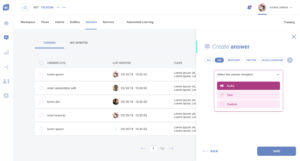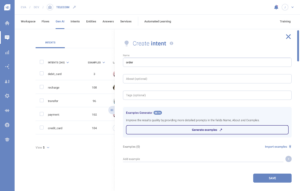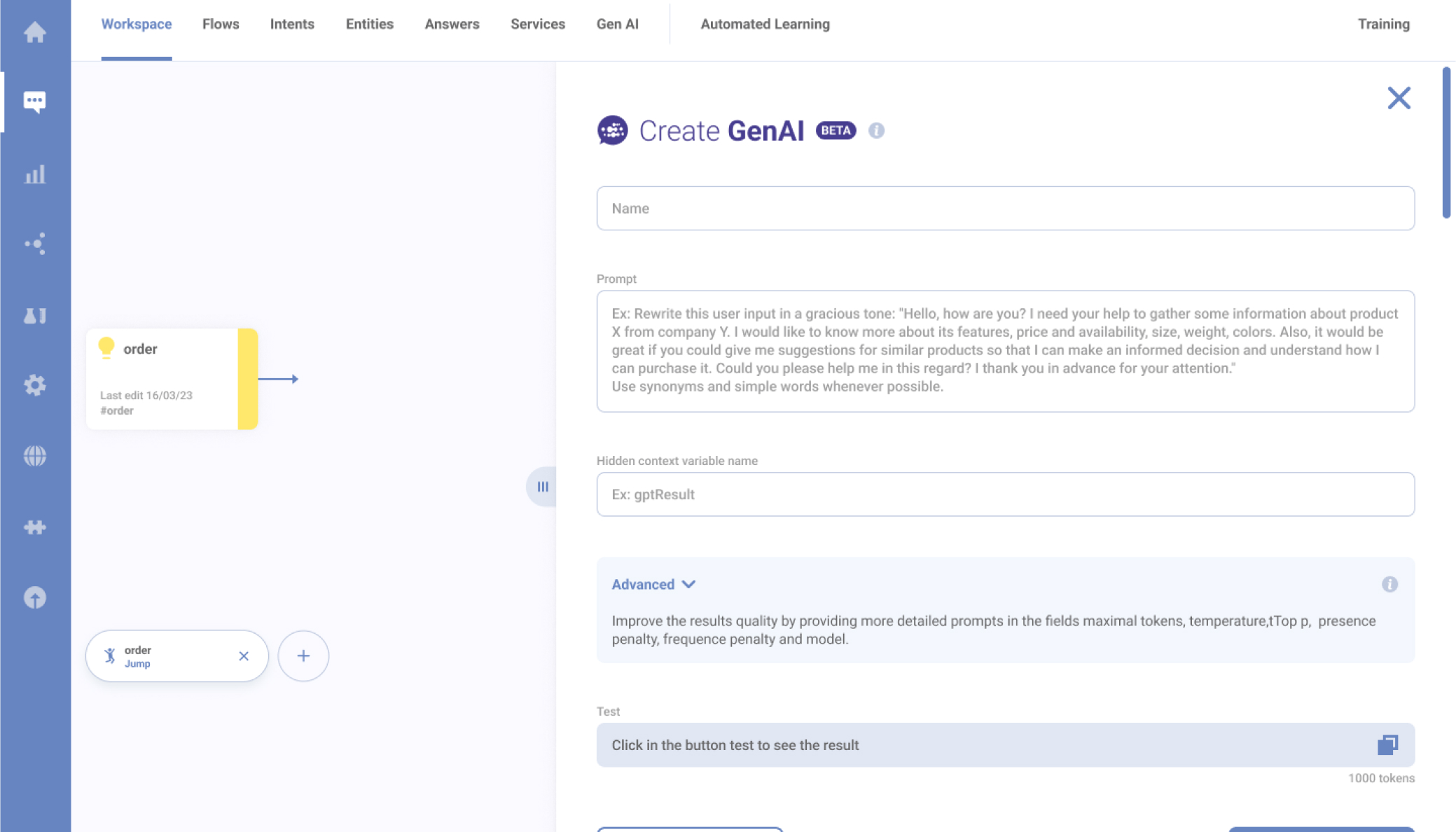
Understanding today's user: a demand for interaction and personalization
Modern users seek experiences that are not only informative but also engaging and customized. They expect interactions that feel natural, intuitive, and tailored to their specific needs and preferences. Businesses must adapt to these expectations by leveraging technologies that can provide these experiences. AI, with its advanced data processing and learning capabilities, is perfectly positioned to deliver on these expectations.The role of AI in crafting customized experiences
AI's ability to analyze vast amounts of data allows for a level of personalization previously unattainable. This technology can tailor experiences, recommendations, and interactions based on individual user profiles, ensuring that each engagement is relevant and meaningful.eva's enhanced capabilities: a case study in AI excellence
Through conversational agents, AI transforms user interaction from a mere exchange of information to a dynamic dialogue. Virtual agents powered by AI can converse with users in natural language, making interactions more intuitive and less robotic. eva’s latest feature pack enhances this by speeding up the creation time of virtual agents and improving the understanding of audio in text conversations, making interactions more fluid and natural.- Interactive and Personalized Webchat: eva’s webchat plugin exemplifies how AI can be used to create more engaging user experiences. This tool allows businesses to customize their web chat interface, aligning with both brand identity and user preferences for a more personalized interaction.
- Innovative Data Analysis and User Insights: eva's funnel charts and data tagging feature showcase the power of AI in understanding user behavior. These tools help businesses gain valuable insights into user interactions, enabling them to optimize the user experience continuously.





Why is it relevant for eva to adapt to the GenAI trends?
With the disruption of Generative AI, it is impossible for a product that works with AI not to use these technologies, because it is at a very big disadvantage compared to its competitors. At eva we have been working with Generative AI for 2 years, when we launched “Automated Learning”, a functionality that allowed us to generate answers from Large Language Models. This continuous adoption of LLM that we have applied within eva has allowed us to evolve our product with capabilities that allow us to put virtual agents into production in a shorter time, improve the assertiveness of the responses that are delivered to users, allow for a better analysis of the performance of virtual agents, among other benefits.Considering the current state of the market, what is the contribution of incorporating user behavior analysis tools in eva?
The tag funnel is a powerful tool that allows to make better business decisions and helps to detect improvement points in the virtual agent performance. With this functionality we want projects to understand the behavior that users are following in the virtual agent flows.What is the criterion for making decisions about which features to include or exclude in each eva release?
Our roadmap is primarily driven by the needs and pain points we discover from our end users and customers, which are converted into outcomes. However, other factors such as market and competitor analysis also play a role.what do you think are eva's next challenges as a product, empowered with GenAI?
As a product, our main challenge is to create better conversational experiences through automation, this includes the use of technologies such as Generative AI, robust analytics and monitoring to make continuous improvements within those conversational experiences, and the continuous development of low-code functionality to ensure a user-friendly platform. As pointed out by our Product Manager, not incorporating AI technologies into a platform like eva would mean a disadvantage against the existing products in the market. In this regard, as NTT DATA we have taken an approach of integrating and embracing these new technologies to help the development of virtual assistants. By taking this approach, we are not only creating more accurate virtual assistants, but also by considering the user’s behavior and incorporating the necessary tools to measure it, there can be a better comprehension of the behavior that users are following inside the virtual agents, as stated by Angela. The latest release of eva reflects our unwavering commitment to the cutting edge of AI, evidenced by the addition of innovative tools designed to adapt to growing business demands in the field of AI. The introduction of the GenAI Cell module, powered by Generative AI, significantly expands eva's capabilities, enabling it to generate better responses and provide more accurate, contextually aware solutions. At NTT DATA we are not only demonstrating effective adaptation to new trends, but also a proactive approach by integrating AI technologies to drive the development of more accurate virtual assistants. We invite you to see how NTT DATA is embracing and adapting to these technologies with our potent conversational AI platform “eva”.




The evolution of cCommerce
In this context, the term Social Commerce appears on our radar. It is important to differentiate it from cCommerce, since it is an evolution of the latter. While cCommerce occurs only on the company's website, Social Commerce refers to a complete sales cycle that takes place through social networks. This cycle includes everything from marketing, promotion of products or services, to post-sales follow-up. It also includes activities that attract potential customers. This is a great opportunity for companies, considering that most of the world's population has at least one profile on social networks (Facebook, Instagram, Twitter, etc.) generating awareness with users and creating a more personalized customer service experience.The impact in numbers in social commerce
According to the study "Digital Marketing in Latin America" carried out by NTT DATA in collaboration with MIT Technology Review, the importance of social networks is highlighted, which takes a preponderant role when defining marketing strategies. According to the study, 94% of the companies surveyed prefer social networks to generate their digital marketing campaigns. Also, because of the pandemic, social networks have become an effective means of communication to maintain socialization and to improve the buying and selling processes.The Role of AI in Improving Customer Care
It is in this sense that nowadays it’s not possible to talk about social commerce without including Artificial Intelligence (AI), which can offer more efficient and personalized solutions. First, AI is capable of processing large volumes of data quickly and accurately. This enables the analysis of customer preferences and the identification of behavioral patterns, which in turn facilitates the personalization of interactions. AI-powered virtual assistants are a prime example of this application, providing quick and relevant responses to customer queries. In addition, AI also improves efficiency in handling queries. Intelligent routing systems can direct customer requests to the right agent, reducing wait times and optimizing resource allocation.The L’Oréal Case: combining different IA types
In this context and leveraging the power of NTT DATA's conversational AI platform and the power of chatGPT AI, L'Oréal, the world's leading cosmetics brand commanded us to develop “Lore”, a virtual assistant that provides advice and beauty recommendations, and helps users in their shopping process in a hyper-personalized way. A pioneering idea in Chile, the combination of capabilities of eva, our conversational artificial intelligence platform, along with the power of ChatGPT, the generative AI of Microsoft Azure OpenAI; helped to create “Lore”, a virtual assistant capable of offering hyper-personalized beauty or makeup advice and recommendations, which also helps customers in their purchasing processes, revolutionizing L'Oréal's social commerce strategy. Taking advantage of the capabilities of AI, L'Oréal decided to take interactions with its consumers to a new level. At its core, “Lore” makes suggestions to customers based on their needs, recommends products that fit those requirements, and directs them to the brand's online store or even allows them to shop in the same application where the interaction takes place. Undoubtedly, social commerce and AI are amazing allies when taking the chatbot experience to the next level, where both elements enhance each other, creating benefits for both the users and the companies that decide to take the challenge. As NTT DATA, we invite you to be a part of the future that’s already developing.




Let’s discover each new functionality on detail
Webchat plugin: Engage with customers effortlessly
The webchat plugin allows you to integrate eva into your website, creating a smooth and engaging customer experience. From eva you can customize the colors, fonts and avatar of the whole webchat, once the configuration is done, we will generate a script that you must add to your website and voilá! Your webchat will be configured and ready to be used by your customers. Whis this feature, you can integrate conversational AI into your website, app and mobile channels. Whether you want to enhance customer satisfaction or simplify user interactions, eva enables you to create a personalized webchat solution that perfectly matches your brand identity, ensuring a dynamic user experience.
Whis this feature, you can integrate conversational AI into your website, app and mobile channels. Whether you want to enhance customer satisfaction or simplify user interactions, eva enables you to create a personalized webchat solution that perfectly matches your brand identity, ensuring a dynamic user experience.
Funnel charts: Analyzing business indicator
Gain insights, make data-driven decisions, identify pain points and optimize user experiences effortlessly with valuable insights about your conversations. The new Tags Funnel will help you better understand the conversation journey, drop-off points, and A/B testing. Tags Funnel enables you to track and analyze the customer journey based on tags used within the Dialog Manager. The tags can be used in cells (intents, entities, services, rules, code, input, etc.), flows, and Automated Learning (questions).
Tags Funnel enables you to track and analyze the customer journey based on tags used within the Dialog Manager. The tags can be used in cells (intents, entities, services, rules, code, input, etc.), flows, and Automated Learning (questions).
Filters by tag in all dashboards: Simplyfing data
To further streamline your data analysis process, eva now allows you to filter data based on tags. This feature makes it effortless to focus on specific customer segments or key areas of interest, enhancing your ability to derive valuable insights and optimize your virtual agent’s performance.With this new filter available in our Dashboards section, you can:
- Refine dashboards: eliminate clutter and zero in on the specific information that matters most to you within the Overview, Messages, and Conversations sections.
- Enhance data organization: tag key points within your conversational flows. This tagging system enables you to categorize, sort, and dissect data within the Messages and Conversations.
Examples Generator
 Creating and managing examples/utterances manually can be time-consuming. That’s why we’ve introduced the Examples Generator, a feature that intelligently generates utterances based on intent name and its description. Get 10 new examples for each generation, and you can generate as many as needed.
It speeds up your development time, enabling you to save valuable resources while still providing an exceptional user experience.
Creating and managing examples/utterances manually can be time-consuming. That’s why we’ve introduced the Examples Generator, a feature that intelligently generates utterances based on intent name and its description. Get 10 new examples for each generation, and you can generate as many as needed.
It speeds up your development time, enabling you to save valuable resources while still providing an exceptional user experience.
Integration with Azure Marketplace
eva is now available in Azure Marketplace. This incorporation allows eva to become increasingly known in the market and facilitates access to the platform from our partners.Processing, understanding, and responding to audio files
Audio-based interactions are becoming increasingly important in the digital landscape. That’s why we’ve incorporated the ability for eva to process, understand and respond to audio files in different channels. This feature allows for a more versatile and comprehensive virtual agent experience, catering to a wider range of customer preferences. You might also be interested in: 8 key strategies to effectively train LLMs




8 Key Strategies for Effectively Training LLMs
- Conversation Data Training
- Reinforcement Learning
- Advanced Context Modeling
- Real-time user feedback
- Generating creative responses
- Adaptation to Individual Users
- Multilingual and Cultural Integration
- Rigorous Testing and Continuous Optimization
eva: orchestrating LLMs
LLMs have proven to be a milestone in AI and their journey promises exciting and transformative terrain. Their future is characterized by constant improvement, increased personalization, real-world applications, and a pivotal role in creativity and education. As these models become more conversationally proficient, they will be able to play a more integral role in a variety of applications, from advanced virtual assistants to customer support systems and beyond. At NTT DATA, we go together with technological innovation, which is why our eva platform has created an orchestrator for LLMs that simplifies complex interactions. This new functionality enhances our platform's ability to orchestrate calls to orchestrate calls to generative AI tools, such as Azure OpenAI services, making it easier to handle more advanced and complex tasks with unprecedented simplicity and elegance. At eva, we use a variety of generative AI models provided by Azure OpenAI (and other vendors) to meet various needs, such as content generation, classification, and data processing.




However, can this evolution be attributed to Generative AI alone? The answer is a resounding NO
While Generative AI enhances the quality of Conversational AI, to truly harness its potential, a solid platform is required. A platform that not only creates virtual assistants but also integrates them across multiple channels and systems, crafting intelligent agents capable of performing complex tasks and interacting contextually with users. eva is that platform. This is where NTT DATA's eva platform comes in, which has been quickly adapted to effectively manage and orchestrate the automation process in enterprise communications. eva is a powerful solution that leverages the benefits of Gen AI and improves enterprise communications. It allows to resolve access to different channels and perform the necessary integrations to achieve key transactions, such as bank transfers, user authentication, airline ticket check-in and much more. In addition, eva accelerates the implementation of Gen AI in Contact Centers, facilitating monitoring, governance, control and providing detailed analytics.eva is ready to lead the game together with Gen AINow let's explore some exciting enhancements to eva that are set to redefine your enterprise's AI journey:
GenAI Cell: The Brain of Your Digital Employees
Introducing the GenAI Cell - an innovative module that integrates Generative AI services, enhancing eva's capabilities to a whole new level. It enables eva to identify intents, classify content, generate responses, and provide accurate, context-aware answers. Furthermore, the GenAI Cell simplifies prompt chaining, linking responses from previous interactions to deliver more accurate and empathetic answers, thereby creating intelligent digital employees who are as effective and empathetic as their human counterparts. eva not only enables prompt chaining, but also surpasses open-source alternatives like Langchain in performance. Its robust security features, coupled with its enterprise-ready solutions, make it a superior choice for organizations. [video width="1288" height="782" mp4="https://eva.bot/wp-content/uploads/2023/07/5_-machine_learning__Original__AdobeExpress.mp4" preload="auto" autoplay="true"][/video]Orchestrating the LLM, prompt chaining: Simplifying Complex Interactions
Our newly introduced functionality enhances eva's ability to orchestrate calls to generative AI tools, like Azure OpenAI services, facilitating the handling of more advanced and complex tasks with unprecedented simplicity and elegance. In eva, we utilize a variety of Generative AI models provided by Azure OpenAI (and other vendors) to cater to diverse needs such as content generation, classification, and data processing. If you wish to link your Generative AI account directly, reach out to us for a seamless integrationAPI REST Integration: Smooth Integration with Your Existing Systems
With this feature, eva seamlessly connects with your existing systems without the need for additional development. It also allows integration with Generative AI services, saving time and effort, and enabling you to streamline your operations with ease. [video width="1912" height="912" mp4="https://eva.bot/wp-content/uploads/2023/07/RestConnector.mp4" autoplay="true" preload="auto"][/video]Looking Ahead: The Future of eva
With continuous innovation at its core, eva is poised to introduce new features designed to elevate your enterprise's AI capabilities:- Examples Recommender
- Answer Assist
- Tag Funnel
How does Gen AI help win the game?
Gen AI's Generative Language Models allow you to create much richer, advanced, friendly, and effective conversations. Best of all, the eva platform is already integrated and ready to orchestrate calls to Gen AI's Generative Language Models and other systems. Gen AI enhances the capabilities of the eva platform in several dimensions. It is now possible to automate many of the actions that were previously performed manually, such as utterance generation, which simplifies the work of linguists. For eva, Gen AI represents excellent news, as it expands and enhances its capabilities. Likewise, for Gen AI, the existence of eva is a great advantage, as it accelerates and simplifies the implementation of this technology in companies, ensuring good governance, solid maintenance, controlled evolution, and efficient management.What’s coming next?
eva is evolving more and more with new Generative AI and Analytics features. Soon you will be able to enjoy the features we are working on today:- Examples Recommender: which makes it easy to create examples in intents from the name and description of the intent.
- Answer Assist: A wonderful help for the creation and configuration of virtual agent answers. The answer assist will have built-in Rephrasing to generate more empathetic responses with more context for the user.
- Tag funnel: With the tag funnel it is possible to see the path that the user is following in the different configured flows, in order to validate different business rules, such as which are the most demanded products, detect if the user is following the correct path of the flow, etc.





The power of eva integrated with LLM and GenAI
ChatGPT started a new trend and a new race. Since then, Google and Amazon have launched their own LLM, and more will come. Thinking about this, eva empowers users with an agnostic architecture, as with NLPs. An LLM Orchestrator is responsible for calling the best LLM, as different functionalities may work better with specific solutions.Trends and future vision for eva
Advances in Large Language Model (LLM) technology are revolutionizing the world of virtual assistants, and at NTT DATA, we are leading this change towards the future. Committed to ensuring that our client’s investment in virtual assistants is more than worthwhile, we have worked on progressive improvements through LLM technology. With this technology, we can optimize the development and evolution process of existing VAs, to further enhance and simplify them. Additionally, we are developing disruptive new models for creating and designing virtual assistants, using innovative techniques such as Zero-shot, Few-Shot, and Prompt chaining, among others. These techniques allow us to create more efficient and accurate virtual agents, resulting in a more satisfying experience for the end user. But that’s not all! At NTT DATA, we continue to innovate in new channels, such as Digital Humans, which, in combination with LLMs, allow us to offer more natural and efficient conversational experiences than ever before. Digital Humans can emulate human conversations, enabling them to offer users a unique and personalized experience.What’s coming up in eva with GenAI
As we believe in the importance of staying at the forefront of technological innovation, we work hard to integrate our solutions with leading platforms in the market, such as Open AI and Azure Open AI. In this way, we can implement solutions for our early-adopter clients directly and seamlessly.We know that for our clients, every second counts, so we want to make the process as fast and easy as possible.We know that for our clients, every second counts, so we want to make the process as fast and easy as possible.In addition, we are using LLM technology to optimize the traditional virtual assistant development process. Thanks to this technology, we can automatically generate utterances and responses, allowing us to train assistants more efficiently and reduce production times. With this, our clients can be sure that their virtual agents will be ready in less time and with greater accuracy.
In the medium term, eva’s most innovative solutions with GenAI
We are proud to introduce our Zero-shot, Few-shot, and Hybrid Zero + Few Shots virtual assistant solutions. These solutions use LLMs to provide our clients with a more personalized and efficient experience. Our Zero-shot assistants require no training, which means we can quickly implement them without sacrificing quality. The Few-shot assistants allow for fine-tuning through a few classification examples, making them ideal for specific and personalized tasks. And our Hybrid Zero + Few Shots models combine the best of both worlds, allowing for an even more personalized user experience. Finally, our virtual assistants also feature Prompt Chaining, a technology that allows our generalist engines to respond to questions and generate real-time answers. This means our clients can be assured that their virtual assistants will always meet their expectations, even in unexpected situations.Discover what we have in store for the near future when it comes to integrating with GenAI
We are going to implement NextGen AI on the eva platform. NLG will take a central role in eva, serving as the default categorization tool (replacing NLP) and the long tail solution. As mentioned above, we are working at different speeds to offer the best solutions for now and for the future, in three areas:Booting automatization for virtual agent development with Generative AI
Optimise the development process of "classic" NLP-based Virtual Assistants by using LLMs. We will provide tools to speed up and reduce design time as well as improve the quality of understanding with these functionalities:- Example Generator: The ability to automatically generate utterances from the name and description of an Intent. This will reduce training time and/or quickly improve existing models.
- Entity Generator: Definition of business entities from prompts. Currently, it is possible to create entities with patterns and synonyms. With Entity Generator, it will be possible to create complex entities with very large datasets with a single instruction.
- Intent Generator: From a text (such as a product manual, internal procedures, or transcriptions), Eva will propose the list of Intents that need to be created so that a virtual assistant can detect them.
- Flow Generator: Based on a text that describes a business process, eva will create a basic flowchart to manage a conversation for that use case. These flows should allow business users to work with eva and define the first drafts of the use cases.
Enhancing the Creativity of the Assistants
Generative AI provides a higher level of possibilities for the generation, creativity and rewriting of texts or generation of images, which, within a conversational context, will make it possible to offer experiences that have never been seen before. We will offer the following capabilities in eva: GenAI Cell:
GenAI Cell:
We started by including the ability to have prompt execution points within the flows. These execution points can be used for many use cases. As we analyze how it is used, we can generate prompt templates or generate new specialized cells or include GenAI in existing cells (such as answer cells or service cells).
GenAI Answer Assistant:
Facilitate and make more creative the creation of virtual assistant responses using the potential of GenAI. It will allow for the Creation of message types, tone, greater creativity in texts, rewriting, summarization, generation of responses in images, video, and audio, creation of carousels, rich text, or auto-generated SSML responses.Reinventing Virtual Agent Creation with the Power of Generative A
 Zero-shot Assistants: Allows for creating an AV without an NLP engine. There is no need for training, just a definition of flows with their intents, entities, etc.
Zero-shot Assistants: Allows for creating an AV without an NLP engine. There is no need for training, just a definition of flows with their intents, entities, etc.- Few-shot Assistants: Fine-tuningis possible with a few classification examples. It allows for fine-tuning at specific points in the Assistant to improve classification quality.
- Hybrid Zero + Few Shots Assistants: For example, the Assistant is generally defined with Zero-shot, but it is possible to specify models with Fine-tuning for some intents.
Improve Conversation Insights
- Topic Classification & Discovery: This allows us to analyze and categorize the content of chatbot conversations. With topic classification, we can identify the conversation topic, while discovery involves finding patterns or trends in the conversation data. By classifying conversation topics and discovering patterns within the data, chatbot developers can identify areas for improvement and optimize chatbot performance. In general, topic classification and discovery are techniques that can help improve the user experience and increase the effectiveness of chatbots in various applications.
- Conversation Quality Assessment: The evaluation of chatbot conversation quality is performed by measuring aspects such as coherence, relevance, and usefulness. Its goal is to improve chatbot effectiveness by identifying areas for improvement, such as gaps in its knowledge, and determining if it meets the user’s needs. Various metrics are used, such as natural language processing algorithms, sentiment analysis, and user opinion surveys. The results are used to optimize chatbot conversational capabilities and improve the user experience. It is an important aspect of chatbot development and optimization to ensure effective communication with the user.





NTT DATA partners with L'Oréal to enhance its digital e-commerce platforms
L'Oréal's goal is to provide tools that are at the forefront of consumer experience technology, delivering added value using artificial intelligence. NTT DATA announced the recent alliance with the leading global cosmetics and beauty company, L'Oréal Groupe, which seeks to develop innovative technological solutions that allow users a personalized experience at any time of the day they need it through digital channels, also improving customer service responses. Since its inception, L'Oréal Groupe has been characterized as a company that constantly embraces innovation, and this is no exception. As a pioneer in beauty-tech, its goal is to push the boundaries of beauty, using science and technology as the basis of its sustainability strategy, satisfying the desires and dreams of all its consumers around the world. On this occasion, both companies indicated that they are working on technologies that will be pioneers in Latin America, and are being developed through NTT DATA's Conversational AI, eva platform, which uses advanced artificial intelligence with Generative AI, capable of understanding and offering hyper-personalized advice to users. "As a company we are constantly researching and trying to develop processes that facilitate and optimize the shopping experience for our consumers. We are excited to bring cutting-edge technology to our customers, we want to explore the use of tools like GenAI to provide an engaging and personalized shopping experience, helping our customers find the best products for their beauty needs," said Arturo Perez Wong Manager Manager DPGP L'Oréal Chile. At the same time, the companies added that this alliance will allow them to capitalize on the advancement of the latest artificial intelligence and big data technologies and apply them in the multiple communication channels they have with their customers, creating a more dynamic, fluid, and intuitive shopping experience in both online and offline modalities. "We are very happy to be able to contribute with all our potential to accelerate the deployment of Social Commerce at L'Oréal, and help them to improve the customer experience, through a new, simpler and revolutionary way of shopping, which saves time and improves users' lives" concluded Santiago Santa María, Director Conversational AI & Generative AI.About L'Oréal
L'Oréal, a world leader in beauty and personal care, is headquartered in Paris, France. With more than a century of history, the company operates in 150 countries and employs around 88,000 employees. L'Oréal's diverse portfolio includes brands such as L'Oréal Paris, NYX, Vogue and Maybelline. The company focuses on innovation, sustainability, and social responsibility, offering high-quality products and personalized beauty experiences for its customers around the world.About NTT DATA
NTT DATA, part of the NTT Group, is an innovative global IT and business services company headquartered in Tokyo. The company helps clients in their transformation process through consulting, industry solutions, business process services, digital and IT modernization and managed services. NTT DATA enables them, as well as society, to move confidently into the digital future. The company demonstrates its commitment to the long-term success of its customers by combining global reach with local focus to work with them in more than 50 countries around the world.







